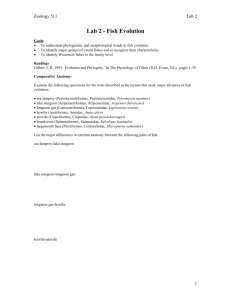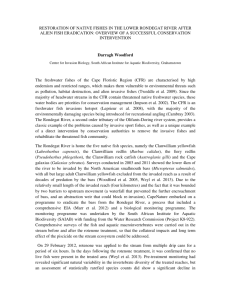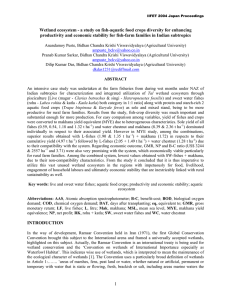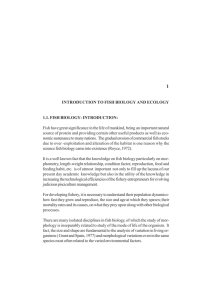Introduction to Water physical properties
advertisement
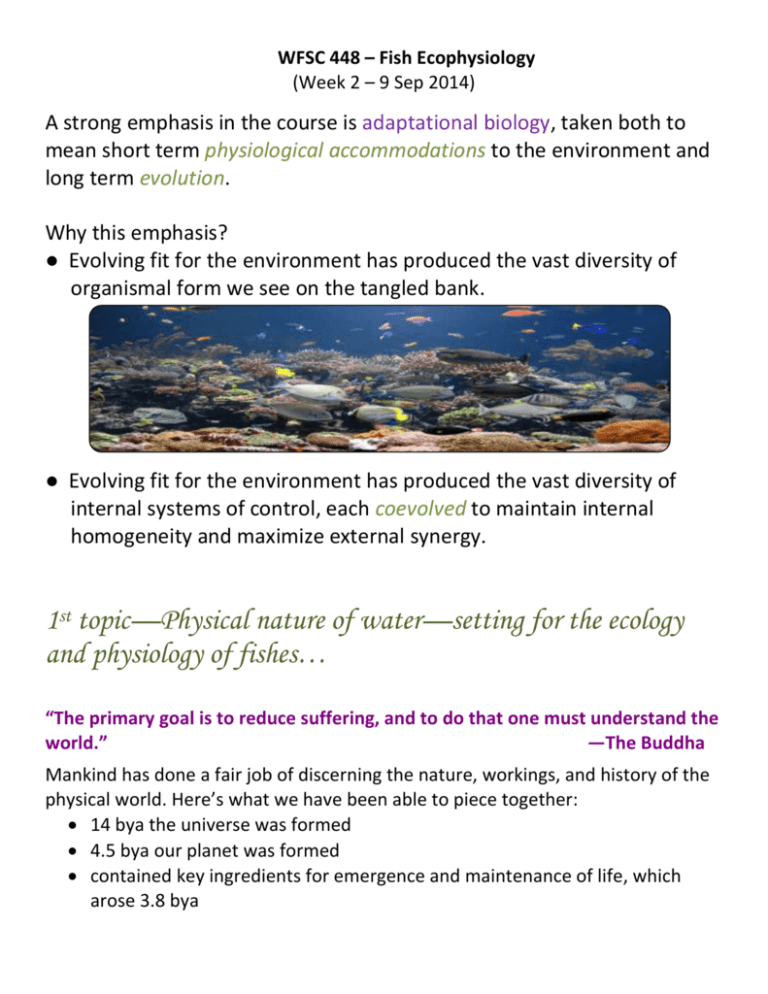
WFSC 448 – Fish Ecophysiology (Week 2 – 9 Sep 2014) A strong emphasis in the course is adaptational biology, taken both to mean short term physiological accommodations to the environment and long term evolution. Why this emphasis? ● Evolving fit for the environment has produced the vast diversity of organismal form we see on the tangled bank. ● Evolving fit for the environment has produced the vast diversity of internal systems of control, each coevolved to maintain internal homogeneity and maximize external synergy. 1st topic—Physical nature of water—setting for the ecology and physiology of fishes… “The primary goal is to reduce suffering, and to do that one must understand the world.” —The Buddha Mankind has done a fair job of discerning the nature, workings, and history of the physical world. Here’s what we have been able to piece together: 14 bya the universe was formed 4.5 bya our planet was formed contained key ingredients for emergence and maintenance of life, which arose 3.8 bya On the latter point, water, carbon dioxide, nitrous oxides, and mineral ions in liquid water started life. Water is the lynchpin. For in water, the chemistry of life, no matter what form it was to take, was possible. Obviously it took the form of what you see today… cellular, nucleic-acid based self-replicating organisms. The dawn of autopoeisis changed the world and began the path to our fish-like existence. "Autopoiesis" (from Greek αὐτo- (auto-), meaning "self", and ποίησις (poiesis), meaning "creation, production") refers to a system capable of reproducing and maintaining itself. Archaea started things off and gave rise in some lineages to the eukaryote, and later to fishes. In fishes there evolved a basic set of organ systems and concomitant physiologies that enabled the evolution of a diverse array of vertebrates including things like dinosaurs and humans. Traits that make us “spiritually” human in this view—love, greed, passion etc.—are mere subtle adjustments to the systems evolved in fishes. So embrace your inner fish. Nearly literally, we are fish. If one follows our branches back on the tree of life one sees we connect, albeit 200 MYA to fish. We are monophyletic with fish (see interesting discussion)… “The thinking behind cladistic classification is based on a confusion between a phylogeny and a taxonomy. A phylogeny has no classes, as noted by Knox recently, while a taxonomy itself has no phylogeny although it may take phylogenetic data into consideration. That signature in our physiology is minimally muddied after millions of centuries of adaptation to terrestrial life (contemplate external anatomy of agnatha).” So a fundamental question is: What is the difference(s) between terrestrial and aquatic life, and why do these differences exist? Water Physical Sciences I (chemistry) Overview Water is dihydrogen monoxide, H2O. It has extremely unique properties that make it vital for probably all life processes, and these properties also make it a major constraint for physiological systems. The structure of water is as follows. Note that oxygen has two electrons to share and hydrogen in its ionic state (a proton, when dissolved in water) has a single electron deficit—thus two H bond to one O: The electron surplus for the O creates a negative charge on its side of the molecule, with positive charge on the 2H side. Because of this shift in charge across the molecule we call water a polar molecule. Water’s polarity allows it to interact with so many other molecules it is called the “universal solvent”. Water even interacts with itself: Hydrogen bonds hold liquid water together. Largely responsible for high viscosity, density and hence mass of water. Normal orientation of water molecules: FYI: Polarity also allows water to interact with an electric field. Disrupted orientations This is how the composition of water was discovered by Lavoisier. Antoine Laurent Lavoisier (1743-1794) is considered to be the father of modern chemistry. He discovered the composition of water by running electric current through liquid water. The electric field breaks up liquid water’s tight conformation (contrast last two figures) and liberates the component gases. This process is known as hydrolysis (hydro: water; lysis: to cut). Lavoisier quickly found there were two component gases, one lighter than air, and one fundamentally like air. One of the gasses he found could be breathed by animals to sustain life. He named that gas oxygen (oxy: acrid; gen: to make) under the (flawed) idea that it is a component of acids. The other (lighter) gas was flammable—but only in the presence of oxygen. He found when the second gas was burned it makes water, so he called it hydrogen (hydro: water: gen: to make). So… electricity takes water apart, and fire puts water together. </FYI> Water can dissolve (bring into solution as ions) most compounds or elements you can think of… solids like iron and rock gases like oxygen and carbon dioxide and other liquids like sulfuric acid and sodium hydroxide Here is what water does to table salt: (consider stage performance of scrum interrupted by a herd of skunks) Water therefore serves as a storage compartment, transfer medium, and chemical mediator for a huge fraction of chemistry on our planet, within organisms, and at the organism-environment interface. We could do the same line of arguments for other cycles, like sulfur. Which should remind you about acid rain: 2H2O + SO2 + SO4-- 2H2S04 Other Unique Properties of Water As for most substances, water becomes more dense as temperatures drop. Except as temperature drops below 4 °C water grows less dense and solidifies at 0 °C. Water has high molar heat capacity allowing it to adsorb and emit relatively large amounts of heat without a change in temperature Water has large latent heats of evaporation and freezing as a result of hydrogen bonds, with the result that phase changes of water are an important heat-transport vehicle Strong cohesion & adhesion (surface tension & capillary action) water (dyed) mercury What are some important consequences you can think of regarding water’s high cohesion and adhesion? More fun with the properties of water: cohesion, adhesion, capillary action and surface tension: http://science.jrank.org/pages/1182/Capillary-Action.html (Note the video at the bottom begins slow but gets good) Ponder: <FYI> Why does rain fall in drops? Why not cubes? (H2O)3 = chemical formula for ice cubes. —Dr. DeWitt </FYI> Major point: Physical and chemical properties of water dominate lives of aquatic organisms in ways largely alien to terrestrial vertebrates • Dimensionality—3D world; requires perceptual shift regarding orientation, different modes of locomotion • Viscosity, Density—Density slows movement and demands streamlining (we must look ridiculous to fish; any wonder why such strong convergence of cetaceans and fish?). Makes water heavy and sticky. • Solvent properties—Water can bear a great deal of solute • Intimacy—when you are in water you are really IN it. • Oxygen capacity— • Air is a constant 20% oxygen, 285 mg·l-1 • Water is 9 mg·l-1 (at 20 °C) and varies • It’s variability that gets you—homeostasis is tough enough to achieve in constant environments! So practice thinking through implications of water’s properties for aquatic organisms?



